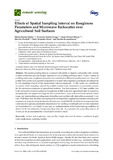Mostrar el registro sencillo del ítem
Effects of spatial sampling interval on roughness parameters and microwave backscatter over agricultural soil surfaces
| dc.creator | Barber, Matías Ernesto | es_ES |
| dc.creator | Grings, Francisco Matías | es_ES |
| dc.creator | Álvarez-Mozos, Jesús | es_ES |
| dc.creator | Piscitelli, Marcela | es_ES |
| dc.creator | Perna, Pablo Alejandro | es_ES |
| dc.creator | Karszenbaum, Haydee | es_ES |
| dc.date.accessioned | 2017-11-15T08:00:44Z | |
| dc.date.available | 2017-11-15T08:00:44Z | |
| dc.date.issued | 2016 | |
| dc.identifier.issn | 2072-4292 (Electronic) | |
| dc.identifier.uri | https://hdl.handle.net/2454/26146 | |
| dc.description.abstract | The spatial sampling interval, as related to the ability to digitize a soil profile with a certain number of features per unit length, depends on the profiling technique itself. From a variety of profiling techniques, roughness parameters are estimated at different sampling intervals. Since soil profiles have continuous spectral components, it is clear that roughness parameters are influenced by the sampling interval of the measurement device employed. In this work, we contributed to answer which sampling interval the profiles needed to be measured at to accurately account for the microwave response of agricultural surfaces. For this purpose, a 2-D laser profiler was built and used to measure surface soil roughness at field scale over agricultural sites in Argentina. Sampling intervals ranged from large (50 mm) to small ones (1 mm), with several intermediate values. Large- and intermediate-sampling-interval profiles were synthetically derived from nominal, 1 mm ones. With these data, the effect of sampling-interval-dependent roughness parameters on backscatter response was assessed using the theoretical backscatter model IEM2M. Simulations demonstrated that variations of roughness parameters depended on the working wavelength and was less important at L-band than at C- or X-band. In any case, an underestimation of the backscattering coefficient of about 1-4 dB was observed at larger sampling intervals. As a general rule a sampling interval of 15 mm can be recommended for L-band and 5 mm for C-band. | en |
| dc.description.sponsorship | This work was funded by the Agencia Nacional de Promoción Científica y Tecnológica (ANPCyT) (PICT 2060), MinCyT-CONAE-CONICET project 12 and SARAT-SAOCOM project 17. | en |
| dc.format.extent | 19 p. | |
| dc.format.mimetype | application/pdf | en |
| dc.language.iso | eng | en |
| dc.publisher | MDPI | en |
| dc.relation.ispartof | Remote Sensing, 2016, 8(6), 458 | en |
| dc.rights | © 2016 by the authors; licensee MDPI, Basel, Switzerland. This article is an open access article distributed under the terms and conditions of the Creative Commons Attribution (CC-BY) license. | en |
| dc.rights.uri | http://creativecommons.org/licenses/by/4.0/ | |
| dc.subject | Surface soil roughness | en |
| dc.subject | Laser profiler | en |
| dc.subject | Height standard deviation | en |
| dc.subject | Correlation length | en |
| dc.subject | Radar applications | en |
| dc.subject | Scattering models | en |
| dc.title | Effects of spatial sampling interval on roughness parameters and microwave backscatter over agricultural soil surfaces | en |
| dc.type | Artículo / Artikulua | es |
| dc.type | info:eu-repo/semantics/article | en |
| dc.contributor.department | Proyectos e Ingeniería Rural | es_ES |
| dc.contributor.department | Landa Ingeniaritza eta Proiektuak | eu |
| dc.rights.accessRights | Acceso abierto / Sarbide irekia | es |
| dc.rights.accessRights | info:eu-repo/semantics/openAccess | en |
| dc.identifier.doi | 10.3390/rs8060458 | |
| dc.relation.publisherversion | https://dx.doi.org/10.3390/rs8060458 | |
| dc.type.version | Versión publicada / Argitaratu den bertsioa | es |
| dc.type.version | info:eu-repo/semantics/publishedVersion | en |



